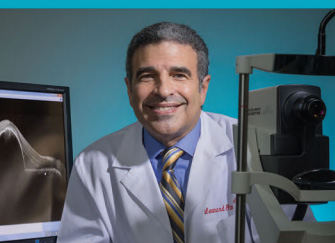Vision loss ranks among the top 10 causes of disability in the United States, and it is a condition feared by many. Among the several vision-threatening diseases, two of the most common are diabetic eye disease and age-related macular degeneration.
Drexel University College of Medicine recently partnered with Moore Eye Institute, a leading eye care provider that specializes in retina and diabetic eye care, to support new research efforts in these areas. Leonard Ginsburg, MD, CDE, chairman of Moore Eye Institute, is the clinical chief of Drexel Ophthalmology and will play a key role in the College's residency program.

Dr. Ginsburg was the first physician in Pennsylvania to use optical coherence tomography. The OCT image on the screen shows retina pigment epithelium detachment from age-related macular degeneration.
Diabetic eye disease is the most common cause of vision loss in Americans ages 20 to 65. High blood glucose and blood pressure can damage the thousands of small capillaries (retinal blood vessels) in the eye. This is known as diabetic retinopathy.
Age-related macular degeneration (AMD) is the most common cause of vision loss in Americans over 65. AMD is a deterioration of the eye's macula, a small area of the retina composed of light-sensitive tissue responsible for your central vision. There are no known causes of AMD, but it can develop as part of the body's natural aging process. Other risk factors include smoking, poor nutrition and high blood pressure.
Ginsburg, a Philadelphia-area native, founded Moore Eye Institute in 1996. The institute is named after his grandmother, Belle Moore, who suffered from AMD.
"I'll never forget when I was 16 years old and my grandmother told me she couldn't see my face. It tortured her," Ginsburg recalls. "I took her to Harvard's Massachusetts Eye and Ear Infirmary, and there was a great retina surgeon who worked with a low-vision doctor. The surgeon suggested cataract surgery, and starting the day after surgery, she could see my face. We were both crying, and it was at that point that I knew I wanted to be a physician."
After graduating from the University of Pennsylvania School of Medicine, Ginsburg returned to Harvard University to complete a fellowship at Massachusetts Eye and Ear, where he trained with the same surgeon who had helped his grandmother years before. While at Harvard, Ginsburg also did a fellowship at Joslin Diabetes Center and learned to perform several cutting-edge diagnostic tests and treatments. He stayed on at Joslin as faculty until moving home in 1991.
After returning to Philadelphia, Ginsburg founded the Retina and Diabetic Eye Institute at Mercy Community Hospital. He was an early adopter of new technology. "We were only the third practice in America to use digital ICG [indocyanine green] angiography, one of the three most important diagnostic tests for macular degeneration," says Ginsburg.
Later, when he founded Moore Eye Institute with Crozer Keystone Health System, Ginsburg was the first physician in Pennsylvania to use optical coherence tomography. "OCT is basically an MRI of the retina. It's a 30-second test that provides a three-dimensional look at the eye. It's by far the most important diagnostic test in all of ophthalmology and the best way to follow macular degeneration and diabetic macular edema," says Ginsburg.
Unfortunately, there is no cure for AMD; however, its progression can be slowed. Treatment varies for the two forms of AMD. Dry AMD, the most common form, is characterized by the presence of drusen (dots of yellow crystalline deposits that develop within the macula) and thinning of the macula. Wet AMD, which affects about 10 percent of those with macular degeneration, occurs when abnormal blood vessels grow underneath the retina, a process called neovascularization.
"If you give a patient antioxidant vitamins and zinc at a high level, you can reduce the progression of dry macular degeneration by 25 percent," Ginsburg explains. For wet AMD, Ginsburg uses a medication to block vascular endothelial growth factor, a substance that contributes to abnormal blood vessel growth. The medicine reduces swelling, leakage and unwanted growth, possibly improving vision.
"There is a large population who don't know they have diabetes until they start having vision problems."
Treatment for diabetic eye disease depends on when it is diagnosed. Advanced stages of diabetic retinopathy and diabetic macular edema may require laser surgery, vitrectomy surgery or medical injections. If detected early, up to 76 percent of all complications, including vision loss, can be prevented through tight blood sugar control.
Ginsburg is often the first to diagnose a patient's diabetes. High blood sugar causes the lens of the eye to swell, which can lead to blurry vision and send many patients in for an eye exam.
"The eye is the only place in the body where you can examine a blood vessel directly. This makes eye exams one of the easiest ways to catch diabetes at an early stage," says Ginsburg. "Unfortunately, with one in five Americans eventually developing diabetes, there is a large population who don't know they have diabetes until they start having vision problems."
Ginsburg is one of the only retina specialists in America who is also a certified diabetes educator. This allows him to bridge the gap between delivering a diagnosis and helping a patient manage his or her disease. By working with Drexel University College of Medicine, Ginsburg hopes to close this gap even more.
"There's the opportunity here to partner with all specialties — endocrinology, nephrology, even public health — and explore the possibilities of a multidisciplinary diabetes center," Ginsburg says. "I joined Drexel because I believe they really care about the patients they see and the students they teach. I envision a future in which Drexel will be the leader in diabetes care in the Philadelphia region."